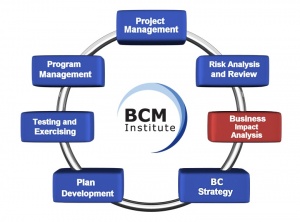CM Business Impact Analysis (BIA)
| 1. Business impact analysis, or BIA, is a phase within the Crisis Management Planning Methodology, except that the Crisis Management Planning Team does not need to conduct this phase but rather liaise with the BCM counterparts to have access to the management-approved list of critical business functions. The relationship is that the Crisis Management Team must understand the critical business functions that may be disrupted should a crisis scenario occur.
2. Business impact analysis, or BIA, is a phase within the BCM planning process. It is the process of analyzing the effect of interruptions to business operations or processes on all business functions.
Related Terms: Business Impact Analysis Questionnaires (BIAQ), BCM Planning Process or Methodology, DR Planning Process or Methodology. Note (1): The BIA should identify all critical business functions, qualify and/or quantify losses as a result of such interruptions, determine the tolerable downtime and minimum resources needed to recover the critical business functions. Note (2): Typically, for the first BCP project the organization is involved in, all business units should be involved during the BIA. For subsequent BCP projects and if there are no significant organizational changes, then only business units with critical business functions will be involved.
| ||||||||||||||||||||||



